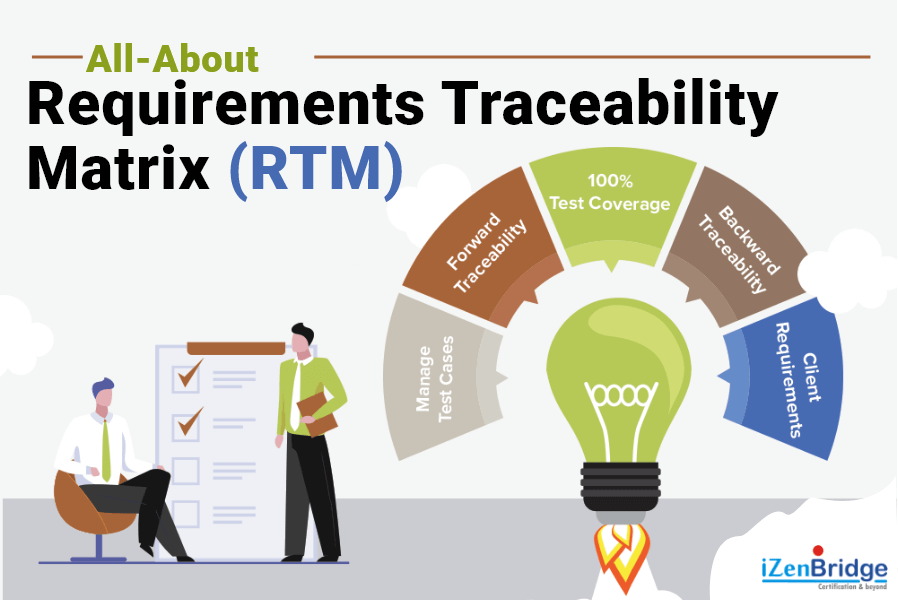

Let’s begin with understanding what Requirements Traceability Matrix is:
Throughout the project Lifecycle list of project and product deliverables are created and these are developed based on agreed project & product requirements.
Project Charter is one of the key deliverable of project initiation where Business Need and high level project and product requirements are documented. Later, high level form of requirements gets elaborated during the detailed planning of scope with the help of “Collect Requirements” and “Define Scope” Processes, and then team develops a list of project and product deliverables as per agreed scope.
Below mentioned diagram reflects how high level requirements elaborated in detailed one and based on those product deliverables are developed:
From this flow you can see Product requirements change its form from Business Need and project objectives to detailed solution requirements, test strategy and test scenarios to product design to verify product development.
So requirement traceability:
PMBOK® Guide defines requirements traceability “Requirements traceability is a grid that links product requirements of their origin to the deliverables that satisfy them”
Requirements traceability matrix is a mechanism to track the requirements throughout the project Lifecycle and each agreed to document product requirement is converted in the relevant product deliverable.
Requirements Traceability Matrix Development Process:
Requirements traceability matrix is developed by maintaining a grid to develop an association with product requirements to product deliverables that satisfy the requirements.
If each requirement is allocated a unique identifier then it is used in Requirements traceability matrix to easily develop a tracking to identify Start and End of each requirement.
Sample Requirements Traceability Matrix:
In Software development, if we are using agile methodology, then the framework eases the development of requirements traceability matrix even though there is no formal introduction of this document.
Requirements changes its form from elevator statement to high level user stories and these user stories are arranged in the Product Backlog and based on Product backlog sprint backlog is created for each sprint or release. User stories selected for a release are converted in product design and in code. Developed code is tested based on test cases of each user story and based on DOD (Definition of Done) a potentially shippable product increment is demonstrated to the customer.
Why do we need Requirements Traceability Matrix:
Requirements Traceability Matrix is a powerful tool to manage the requirements of the product and to identify inconsistencies between those requirements, project plan and associated product deliverables.
In order to identify and track inconsistencies between the requirements and the project’s plans and work products, it is very important to get commitments for product requirements from the team members and from the customer.
Requirements Traceability Matrix serves as a tool to identify Start and End of each requirement and as a result give us an assurance that each agreed or baseline requirement delivered at the end.
Requirements are considered and priorities in a way that deliver business value and it will be answered by linking each stage of requirements with its changing form. If, any product deliverable is created and if it is difficult to link it to the project objectives, then it is suspected about its adding value to the Business. Each requirement should add value by linking it to the business and project objectives.
In addition, Requirements Traceability Matrix serves the ease in change management because during Impact analysis, we need to consider each CI, here CI is the component of a service or product which is under configuration management control directly associated with change management. Requirements Traceability Matrix provides visibility of key CIs involved in the product or service development and those need to be considered as part of impact analysis.
So managing changes to the product from baseline requirement documents and test cases to the product development, Requirements Traceability Matrix is an effective tool.
You can watch and listen to the video presentation on more details of Requirement Traceability Matrix:
You can share your queries and feedback on our discussion Forum. You can also log into our YouTube channel watch the video on the same
Enroll to our FREE PMP® Certification Introductory Program to learn more about PMP® certification Enroll to our FREE PMI-PBA® Certification Introductory Program to learn more about PMI-PBA® certification
No Trainings found